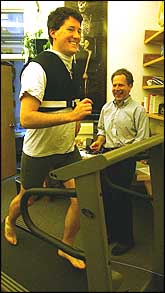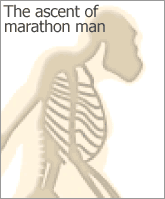|
2002 BOSTON MARATHON
The running animal In the evolutionary race, scientists find humans were built to outlast the competition By Gareth Cook, Globe Staff, 4/9/2002
''Humans arose as pirates of the savanna,'' said Dennis Bramble, a professor of biology at the University of Utah. ''What humans are really good at is running long distances, where they have a goal in mind. It allows you to shut out the discomfort and the pain, and concentrate on the prize.'' In the past, paleontologists have noted the development of large brains, capable of great thoughts, and deft hands, capable of making tools, as crucial innovations that lead to the triumph of Homo sapiens. But now Bramble and a small group of scientists are arguing that running ability was just as crucial an innovation - that along with ''Man, the toolmaker,'' belongs ''Man, the runner.'' The evidence they have gathered has been derived from ancient bones, modern hunter-gatherer tribes, and a new understanding of human anatomy. Humans are not nearly the fastest in the animal world, but have a stunning, almost unparalleled level of endurance. When the world's best runners gather next week for the 106th Boston Marathon, they argue, it will not be a celebration of unusual human ability so much as a celebration of an ability that makes us all human. ''I believe one of the driving forces in our early evolution was the ability to run long distances,'' said Daniel Lieberman, a professor of biological anthropology at Harvard University who is studying how running has shaped the human body. The work is controversial among paleontologists, and even its proponents emphasize that their findings are preliminary and somewhat speculative. But the ideas have the potential to recast human history, and perhaps give doctors new insights into the body's construction. In part, scientists say, the developing field is an outgrowth of a seemingly unlikely team - paleontology and engineering. Biologists have found that engineers can provide insights into how life forms are built and how they move, an area now called biomechanics. And as biomechanics has proceeded on a swell of technological advances, such as increases in computing speed, it has also turned its attention to extinct animals. ''Animal locomotion is a really hot topic these days, and there are enormous advances being made, because the technology is really there,'' said John R. Hutchinson, a postdoctoral researcher at Stanford University who published a paper last month showing that Tyrannosaurus rex could not run as quickly as previously thought. ''The tools have caught up with the questions.'' The story of human running seems to begin with the Australopithecus, a group of animals in the human family tree that came before the genus Homo. The Australopithecenes were more adapted to a forest environment, with shorter legs like a chimpanzee. They were not the elegant, upright runners that humans are, but they didn't need to be. As the ancestors of humans moved to the open savanna around 2.5 million years ago, though, their body design began to change. By the time of Homo ergaster, about 2 million years ago, our ancestors looked like runners, according to Lieberman. Most obvious are the much longer legs, but the anatomy is filled with more subtle signs that running is important. The limbs are tapered, with more of the mass concentrated near the hips, an adaptation that is seen in all kind of animals where running is important. The reason is simple physics: The more mass there is far away from the swivel point, the more energy it takes to move. Big, heavy feet, for example, would slow a runner down. ''Ronald MacDonald would have to use a lot more energy to run than you or me,'' Leiberman said. The body also has a system of tendons, most famously the Achilles, which act as springs, conserving energy by allowing runners to literally bounce off the ground. The Achilles only functions this way during the fast pace of running. At his Harvard laboratory, Leiberman is now focusing on a less-well-understood structure, called the Nuchal ligament, which he believes is crucial in keeping the head steady during running. Similar structures are pronounced in other running animals, but not in the human family tree before Homo, Leiberman said. By carefully observing human runners on a treadmill, he hopes to show that the ligament is a specific adaptation to running. Another researcher in the Leiberman lab is examining another problem - the intense shocks that a running body must absorb every time a heel lands. The body is specially designed to absorb these shocks, with larger joints and other adaptations, said John Polk, a postdoctoral researcher at Harvard. But he is uncovering evidence that trained runners make slight adjustments in their runs to reduce the power of the heel strikes. ''Ultimately, we may have some idea of how to improve people's training, to reduce running injuries,'' Polk said. Researchers also have solved one of the paradoxes of human distance running: Humans often use up more energy than some animals when running the same distance, but they can run farther because their bodies stay cool. Humans have powerful sweat glands, and because they are virtually hairless, the sweat works to cool down the skin through evaporative cooling. Humans are extremely good at dissipating heat, while animals trap it with all their hair, said James Carrier, an associate professor of biology at the University of Utah. ''We are the best sweaters on the planet,'' said Carrier. This is why some theorize that humans once functioned as endurance predators, chasing down faster game by following them until they were exhausted. Anthropologists have recorded stories of hunters who could wear down much faster animals, such as Bushmen chasing zebras, or Navajo Indians chasing down pronghorn by relentlessly pursuing them, according to Bernd Heinrich, a professor of biology at the University of Vermont, an author of ''Why We Run: A Natural History.'' Since the development of tools, the ability to run distances has not been nearly as important to human survival, but the ability remains as a kind of evolutionary echo. Today, when scientists see marathon runners, they say they are reminded of this past and how little is still known about it. But when the elite runners go by, moving gracefully despite two hours of intense exertion, they say they feel a simple rush. ''Mainly when I see those guys running, I see what everybody else sees,'' Carrier said. ''I see beauty.'' Gareth Cook can be reached by e-mail at [email protected].
This story ran on page C1 of the Boston Globe on 4/9/2002. |
|||||||||


 he marathon likely began not in Greece, but on the vast savannas of Africa some 2 million years ago. Under a beating equatorial sun, the runners would have plunged through the grass, aiming toward a column of circling buzzards many miles in the distance. Beneath the buzzards lay a fresh kill. And the runners - our distant ancestors - would have been racing the clock for survival: If they were fast, they would find food for their families; but if they were slow, they would find only bones, picked clean by other scavengers.
he marathon likely began not in Greece, but on the vast savannas of Africa some 2 million years ago. Under a beating equatorial sun, the runners would have plunged through the grass, aiming toward a column of circling buzzards many miles in the distance. Beneath the buzzards lay a fresh kill. And the runners - our distant ancestors - would have been racing the clock for survival: If they were fast, they would find food for their families; but if they were slow, they would find only bones, picked clean by other scavengers.